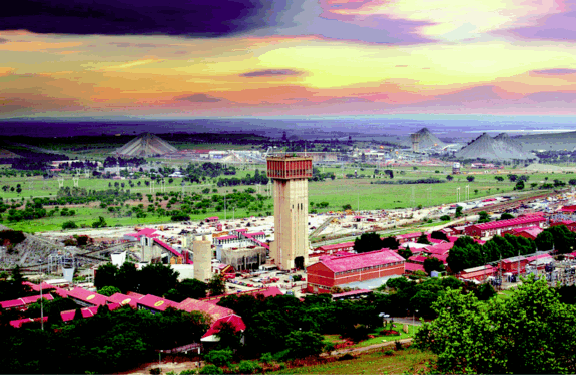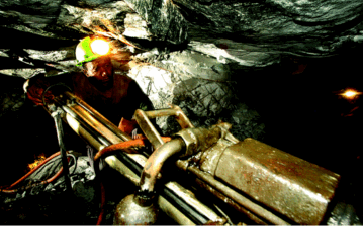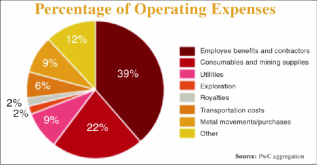South Africa’s gold industry is in a fight for survival. Declining production, rampant labor unrest and ever deeper mines are crushing once-mighty producers.
By Gavin du Venage
Union demands for above-inflation pay rises are only the latest blow to the industry, leading many to ask if it’s time to fundamentally rethink the way South African mining is carried out. “We can’t continue giving double-digit increases when productivity is declining,” Gold Fields CEO Nick Holland said at a recent briefing. “That’s not sustainable. Everybody knows that. All we are doing is hastening the end of the industry. You can’t expect people to keep running businesses at losses. The mining industry has to be restructured.” As a result, mines are adopting different tactics to survive.
 |
| AngloGold Ashanti’s Tau Tona mine plans to integrate a new backfill technique with a reef boring system. |
Recently, Gold Fields unbundled three old, deep-level gold mines in South Africa into a newly listed company, Sibanye Gold, leaving it largely free of local operations and retaining only its modern South Deep operation that is less reliant on labor. The newly orphaned Sibanye announced it will axe 1,110 jobs as it struggles to keep its Beatrix West mine in the Free State going after a fire shut it down in February. Beatrix West contributed 80,000 oz/y of gold, a quarter of Beatrix’s annual output.
At the end of May, Sibanye CEO Neal Froneman said the company was also going to halt development expenditure, which it hoped would cut costs sufficiently to return the mine to breaking even, if not making a small profit, at the prevailing rand gold price. There is enough development underground to keep the mine running for a year, Froneman said.
Analysts have wondered whether competitor Anglo Gold Ashanti would follow the Gold Fields lead and spin off its South African assets, leaving it to focus on its global operations. So far, however, the company has denied it intends doing so.
South Africa has produced around 40% of all the gold ever mined, according to Reuters, but output is now shrinking at 7% per year, and the trend is accelerating. Even though South Africa is still believed to have 47,000 metric tons (mt) of gold reserves, or a global share of 12.8%, according to the U.S. Geological Survey, the one-time champion has slipped to fifth in production behind China, Australia, the U.S. and Russia.
Realizing the Industry is Losing Ground
The South African government has acknowledged that mining requires change to survive, and that newer methods are needed. Much of the conversation centers around productivity, and the need for new technology. “There are misconceptions about productivity,” said Roger Dixon, chairman and corporate consultant at SRK Consulting in Johannesburg. “For those who think that it can be increased by getting rid of labor and introducing technology, I have news for them: it’s not as easy as that.”
Deep level mines have to be accessed by shafts that drop up to 4 km into the earth. Workers then have to travel to the face, which can be kilometers away. Dixon noted that miners were spending up to 10 hours a day at work, but almost half of that was spent moving to and from their stations.
“A miner works an eight-and a half hour shift, with a couple of hours overtime. He spends three or four hours walking. How is he supposed to increase productivity? Impossible,” Dixon said. “It’s not the work he is doing, it’s the time he has to do it in.”
 |
| Sibanye’s harvest production plan shows steady depletion through 2028. |
Some companies were looking at increasing shifts to 12-hours, but with temperatures at deep levels reaching 130°F it would be pushing human endurance to the extreme.
Dixon was also skeptical that technology would lead to the large-scale replacement of humans underground. “We missed out on the mechanization era. Now people want to move directly into automation,” he said. I am not sure this can be done.”
South African mines have lagged their international counterparts in research and development, leaving them at a disadvantage. While Australian and Canadian firms had invested around 5% of their turnover into new ideas, South African companies set aside almost nothing for this purpose.
Instead, they relied on the belief that they had cheap labor at their disposal. “Labor never was cheap. Not if you take into account all those numbers—the cost of hostels and accommodation, nutrition, HIV-AIDS treatment. Cheap labor was an illusion,” Dixon said.
It’s not that zero innovation has taken place. Companies over the years introduced—or tried to—a variety of ideas. These ranged from underground chair lifts to reduce traveling time to directional drilling, which has revolutionized the oil and gas industries. Even “solution mining”—turning gold bearing rock to sludge using acid—had been attempted. Many of these were now used to a greater or lesser degree, but none had provided the revolution needed to replace men in significant quantities, or overcome the challenges related to working at great depths.
Reef-boring at Tau Tona
A possible exception is Anglo Gold Ashanti, which recently said it was exploring technology it described as a “game changer.” During a recent briefing, Srinivasan “Venkat” Venkatakrishnan, the incoming CEO, said a pilot project at the Tau Tona gold mine, currently the world’s deepest, west of Johannesburg near the town of Carletonville, had provided impressive results. The new technology had saved time and reduced underground waste.
 |
| While other gold producers invested in mechanized mining, the South Africans relied on labor-intensive practices. |
“It could double the reserves of the company, from a South African point of view. It could potentially add another 30 million ounces,” Venkat said. The technology is now being rolled out at other mines and the cost of its implementation would be in the order of $40 million over a three-year period. This, he added, “was not a lot of money.”
Drilling had been substantially speeded up, from 3 m/d, to a breakneck 20 m/d, Venkat said. Ultra high-strength backfill was being used to end the need for large pillars within tunnels.
According to an Anglo Gold case study on the project, blasting—and the need to remove people from higher-risk areas—has been reduced, which facilitates continuous mining. Reverse-circulation technology is applied to geological drilling, to ensure accelerated geological information. Enhanced orebody information is a critical ingredient in transforming the mining method from its current labor-intensive process to a continuous mechanical method.
In reef boring, the first prototype raisebore machine completed five test reef holes using a double pass technique, the company noted. Further tests using a second prototype raisebore machine have commenced, making use of a single-pass technique. The second prototype machine is more powerful, and has resulted in increased drilling rates by incorporating improved forward-and-backward thrust and rotation control.
Substantial progress had also been made in the design and testing of ultra high-strength backfill. Surface tests established that it could be pumped over the required distances, and that it would achieve the backfill strength needed for the reef-boring application at Tau Tona. An underground batch plant was built in February.
Planning for the testing and engineering design of a bulk underground application is under way, with testing that had began in March. These tests involve pumping of the product over greater distances, as well as the viability of continuous mixing as opposed to the batch mixing processes, the company noted.
However, it is not clear how applicable this technology would be to the company’s other operations. Dixon questions whether the technology is ready for a full rollout, or whether further development is needed. Anglo Gold was not immediately available for comment.
Dixon speculated that Anglo Gold’s approach would depend on reducing the waste-to-reef ratio. Currently, the stope height would be 110 cm; the top 60% waste material, and the bottom 40% gold-bearing ore. The waste area was needed to enable men to access the narrow reefs. The greater the width extracted, the greater the pressure on the roof, which means the roof quickly begins to sag downward, leaving little room to work.
But the waste mined still has to be hauled to the surface, at huge cost. Anglo Gold’s strategy to focus on the gold reef itself would greatly reduce the waste that needed to be removed. The difficulty, said Dixon, was whether the technique would work if the reef struck a geological fault, which could put the reef above—or below—the line of the preceding drill work. A faulted reef would be challenging to follow in such narrow confines.
“It’s a great idea, but it’s a long way between thought and application,” Dixon said.
Human Resources and the Community Influence
Technological innovations would drive the mines of the future, which would need to be run by young people with the appropriate skills, Minerals Minister Susan Shabangu told South Africa’s largest mining union in late May.
“The mines of the future will have to be modeled differently to those who have characterized this industry for the past 136 years,” Shabangu told South Africa’s National Union of Mineworkers. “These mines will inevitably have to accommodate young people, who will need to operate them, with the appropriate skills, technological knowledge and training.”
The government itself is also an impediment to change, some argue. It has sided with unions over retrenchments and even threatened to withdraw mineral rights from companies that embark on job cuts.
 |
| Although labor costs have decreased from 44% to 39% between 2011 and 2013, it is still the largest cost component for the South African business. |
“The social environment around mines is a time bomb,” said Andries Rossouw, director of Mining and PriceWaterhouseCoopers in Johannesburg. “When companies want to close shafts that are not profitable they come under intense government pressure to keep them open. This affects their flexibility with regard to labor and the costs involved.”
He noted that labor accounted for up to 50% of costs for deep level mining. Unless attendant costs could be lowered, or productivity increased, the outlook for operators was bleak. However, he did not expect a return to hedging, the much-maligned strategy companies employed during the last gold downturn. Mining houses would try and lock in future income by forward selling gold they had not yet mined.
Critics of the strategy say it cost mines dearly as it kept a ceiling on the price for most of the 1990s, and when companies began unwinding their hedge books those with forward contracts were badly burned as they were forced to sell at prices lower than what competitors were achieving on the open market.
“I don’t think hedging will come back significantly,” said Rossouw. “It cost Anglo Gold Ashanti billions. There were a lot of lessons learned and I don’t think there is a rush to enter these agreements again, unless they can hedge the cost side of things.” By controlling the price they sold gold at, but not the cost of production, mines severely limited their earnings ability, he added.






